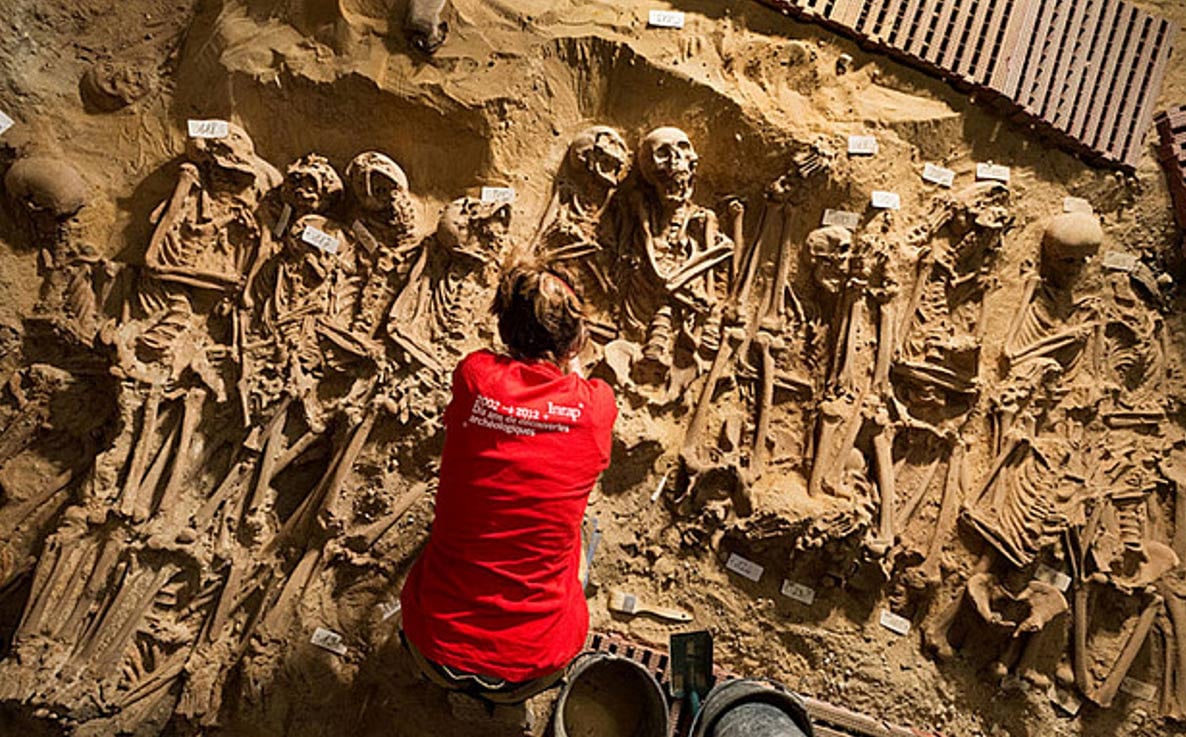Old skeletons, possibly plague victims, found under Paris grocery
Archaeologists have unearthed the skeletal remains of 200 people underneath a supermarket in Paris on the site of an old hospital where victims of the Black Plague had been known to be buried. It was thought, however, that the remains had been moved.
The Telegraph newspaper reports archaeologists were hired to assess the site before rebuilding was done at a Monoprix supermarket. They had expected to find some bodies but were surprised to find so many. The bodies, men and women and children mixed in together, were laid head to toe, alternating, apparently to save space. The bodies are in the earth underneath the store’s basement.
The scientists will test DNA to determine how the people died. Current speculation is they died in a plague, possibly the Black Death that swept Europe from the 14 th to 16 th centuries, or possibly in a famine. The scientists will also do carbon dating to see how old the bodies are.
It’s estimated half of Paris’ population of 100,000 died in the Black Plague of the 14 th century.
“In Paris, where the plague lasted through 1349, the reported death rate was 800 a day, in Pisa 500, in Vienna 500 to 600. The total dead in Paris numbered 50,000 or half the population,” says the book A Distant Mirror by Barbara Tuchman.

Paris Catacombs (Janericloebe/Wikimedia Commons)
The site where the bodies were found was the cemetery of a hospital from the 12th to the 17th centuries. Authorities thought the bodies had been moved in the 18 th century to the Paris Catacombs. The catacombs house the bones of 6 million people transferred from Paris cemeteries 200 years ago.
Archeologists with the French National Institute for Preventive Archaeological Research (INRAP) did the excavations. They intend to test DNA to determine how the people died.

An archaeologist works at the site (Denis Glikman/Inrap)
Isabelle Abadie, an archaeologist on the project, said the bodies were placed with care, not just thrown into a pit. There are eight graves, one of which contained 150 bodies buried in layers.
“The bodies appear to have been buried all at the same time, which [Abadie] said suggested they might have been the victims of the plagues which struck Paris in 14th, 15th and 16th centuries. Carbon dating will be carried out to determine when the mass burial took place. Fragments of medieval ceramics were found among the bones along with pottery dating from more recent times. The remains are due to be taken for study to an INRAP site, after which the state will take charge of their final resting place,” The Telegraph reports.
If the people did die of the plague, it was a common and grisly way to die at that time. The article titled ‘Black Death’ at Saylor.org says the plague killed an estimated 30 to 60 percent of Europe's population. By 1400 it reduced the world's population from an estimated 450 million to between 350 and 375 million.
“This has been seen as having created a series of religious, social and economic upheavals, which had profound effects on the course of European history. It took 150 years for Europe's population to recover. The plague returned at various times, killing more people, until it left Europe in the 19th century,” the Saylor.org site says.
There had been an earlier plague in the 700s A.D., the Plague of Justinian, that may have killed 40 percent of Europe’s population.
As modern science hadn’t even been established yet, people of the Middle Ages circulated theories about how the plague started. Saylor.org says:
Medical knowledge had stagnated during the Middle Ages and the most authoritative account at the time came from the Medical Faculty in Paris in a report to the King of France, which blamed the heavens—a conjunction of three planets in 1345, which caused a ‘great pestilence in the air.’ This report became the first and most widely circulated of a series of ‘plague tracts’ which sought to give advice to sufferers. That the plague was caused by bad air became the most widely accepted theory.
Featured image: Archaeologists with the French National Institute for Preventive Archaeological Research (INRAP) plan to test the DNA of the remains. (Photo: Denis Gliksman/Inrap)
By Mark Miller


















Comments
makes you wonder what is under the floor of the food you eat